
|
After a two-year absence, the Southern California Timing Association and competitors were back at the Bonneville Salt Flats for Speed Week 2016.
Poor salt conditions and inclement weather prevented the event from taking place in 2014 and 2015.
The 2017 event held from August 12 – 18 was the 69th running of Speed Week.
There was an entry list of over 400-competitors coming from as far away as Australia and New Zealand and as close as Canada.
Vehicles racing at the Salt Flats compete in one of seven broad categories depending on their construction and the technology employed.
Within each category are a number of classes.
- Special Construction Category: This represents vehicles competing within the quickest classes.
These are hand constructed vehicles not modified production cars.
Within in this class, there are Streamliners (covered-wheels) and Lakesters (open wheels).
Modes of power in these classes are gasoline, diesel, electric and turbine engines.
- Vintage Category: This category is for cars produced before 1948.
- Classic Category: This category is restricted to coupes and sedans produced been 1928 and 1981.
Minimal modifications are allowed to the bodywork and engine management systems are limited to OEM designs.
- Modified Category: This category includes domestic and foreign coupes and sedans.
These vehicles have been modified so that they do not meet the rules of other categories.
- Production Category: Vehicles in this category have a very limited number of modifications.
It includes – production based coupes, sedans, grand touring sports cars and pickups with different induction systems.
- Diesel Truck Category: This a catchall for diesel trucks constructed with varying degrees of technology.
- Motorcycle Category: This category includes production, modified, special construction, streamliner and sidecar classes.
Within each category there are a number of classes – speed records are set for classes.
Classes are determined by attributes such as engine displacement, fuel type, induction system, body style and modifications, etc.
During the week a number of new records were established.
Eleven drivers ran fast enough to join the 200-mph Club.
The quickest of all the competitors during the week was George Poteet - he recorded a speed of 438.643-mph.
|
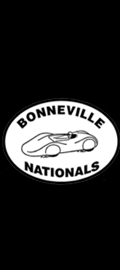
|
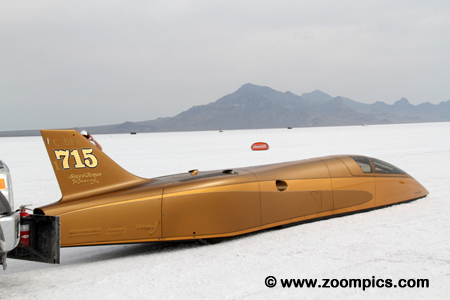
|
On the first day of racing, Danny Thompson recorded a speed of 435.735-mph in the Challenger II.
In an attempt to back up this time he lost an engine and was finished for the week.
The only other vehicle to match Thompson’s pace was the Speed Demon of George Poteet.
Poteet’s Blown Fuel Streamliner is powered by a 444-cu.in. V8 Chevrolet motor.
He was able to run 438.643-mph earning him the Hot Rod magazine trophy.
|

|

|
The Terry Rate’s team had difficulty meeting licensing requirements until they identified their GPS unit as the culprit.
During the qualifying runs, they were instructed by officials to meet specific speed targets.
The GPS indicated that they were successful. However, the officials told them they were too slow.
The Canadians realized the GPS was reporting in metric (the measure in Canada) which meant 100-kph was only 62-mph.
|

|
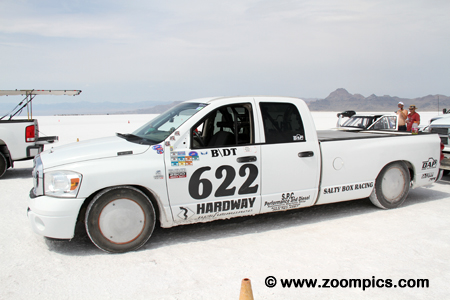
|
A number of new records were established during the 2017 Speed Week - one driver, Mike Strasburg became a Charter Member of the
300-MPH club. Eleven competitors delivered performances that earned them a spot in the 200-MPH club.
Two of these drivers, Tim and Ryan Boyle shared the Salty Box Racing 2008 Dodge Pickup fitted with a 408-cu.in.
Cummins Diesel to achieve this milestone.
|

|
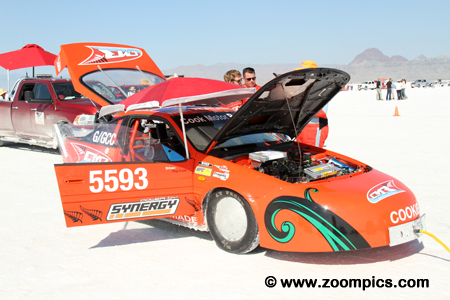
|
This ‘90s Nissan NX is fitted with a 2-liter V8 power-plant.
The motor was constructed by mating two BMW S1000RR motorcycle engines.
The Synergy designed motor revs to 14,600-rpm and produces 420-horsepower – the original 2.0-liter NXs made 140-horsepower.
Before the car’s transmission failed driver, Reg Cook went 184-mph.
|

|
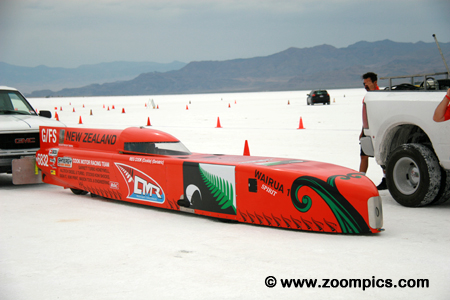
|
A second car entered by Cook Motor Racing of New Zealand and driven by Reg Cook was this Gas Streamliner.
This Streamliner called Wairua 1 is powered by a 1998-cc Synergy V8 and competed in the G/GS class.
After a week of racing the team recorded a run of over 260-mph.
|

|
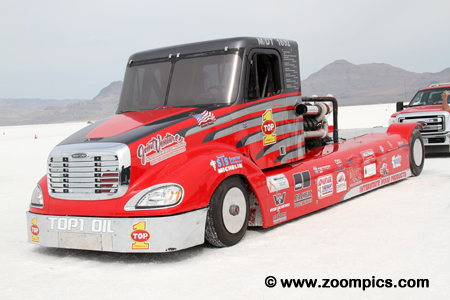
|
The Joint Venture entry is owned by Don and Dale Lemmons of Washington State.
This massive 1997 Freightliner competes in the Unlimited Modified Diesel Truck class (U/MDT).
The Freightliner is powered by an MTU 2000 Diesel which is a 24.1-liter V16 engine.
If that isn’t enough the motor has been fitted with four turbochargers to produce over 4,000-horsepower.
It has achieved a speed of 228.804-mph.
|

|
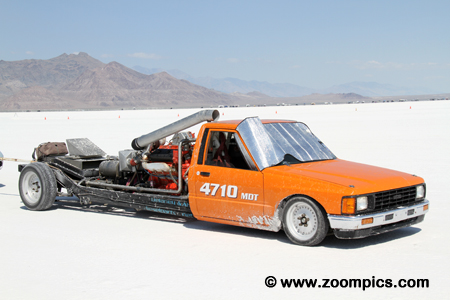
|
Another truck competing in the Unlimited Modified Diesel Truck class is this 1986 Toyota Pickup.
The owner Jim Dunn of Thousand Oaks, California has fitted this Toyota with a 426-cu.in. Detroit Diesel.
This vehicle is also equipped with a very large turbocharger. Sharing the driving duties are Gary and Bailey Dunn.
|

|
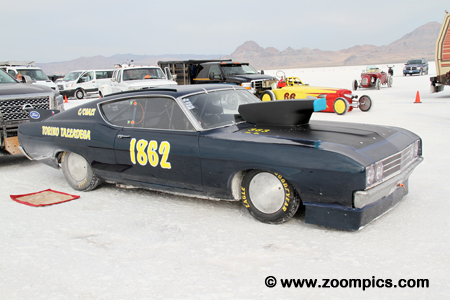
|
This 1969 Ford Torino Talladega was entered and driven by Larry E. Wilson.
Named after the Talladega Superspeedway, it was Ford’s aerodynamic response to the Plymouth Superbird that was produced for
NASCAR by Chrysler. Based on the Ford Torino, only 754 of these specialty models were constructed to meet the homologation
requirements for competition. The Wilson entry uses a 368-cu.in. motor.
|

|
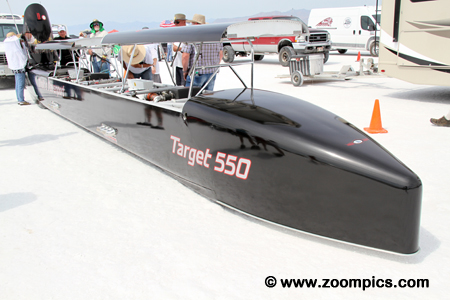
|
Conceived in 1985 with construction being in 1998, the Target 550 team has an objective to exceed the speed record
for conventional wheel-driven, piston-powered vehicles by over 100-mph. Making this car unique is the two Dodge 510-cu.in.
V8 Hemi engines. The induction system includes Whipple superchargers.
Air shifted four-speed transmissions from B & J are used to drive the wheels.
|

|
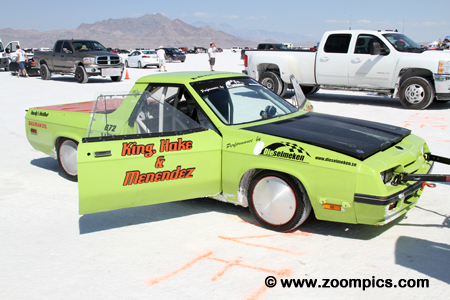
|
The Dodge Rampage was manufactured by Chrysler between 1982 and 1984.
The Rampage was equipped with a 2.2-liter carbureted four-cylinder engine which produced 96-horsepower.
Owner and driver, Steve Menendez has fitted this Rampage, called the Salty Frog, with a 2.0-liter Mercedes
Diesel engine to compete in the Diesel Truck category.
|

|
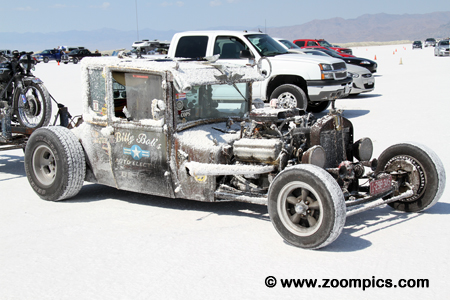
|
Included among the cars, trucks and motorcycles attempting to establish new speed records at Bonneville are some interesting
spectator vehicles. A member of the Buzzards Racing team brought this Rat Rod.
The amount of salt accumulated on this car is a good indication of how much use it got during the week.
This Rat Rod started life as a 1927 Model T Ford and the original engine has been replaced with a 1953 Desoto.
|

|
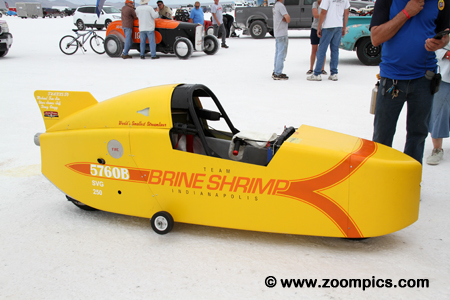
|
Probably the smallest motorcycle competing at the 2017 Speed Week was the 2011 Timmerman.
The Timmerman is in the 250-cc Motorcycle category. Owner and driver, Randall J.
Timmerman uses a 250-cc Cushman to power the tiny bike. Cushman Motor Works is best known for manufacturing industrial vehicles.
However, they produced Scooters beginning in 1958 and ending in 1965.
|

|
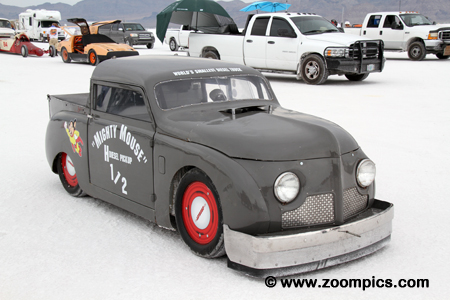
|
This is a 1947 Crosley Pickup. The Crosley Corp. was founded by Powel Crosley.
Crosley’s vision was to manufacture subcompact vehicles. The first cars, produced in 1939, were convertibles.
Later the company introduced sedans, panel and pickup trucks.
This 1947 model was originally fitted with a 742-cc four-cylinder engine.
Owner, David Johnston has replaced the original power-plant with a 1.5-liter Renault Diesel.
|

|
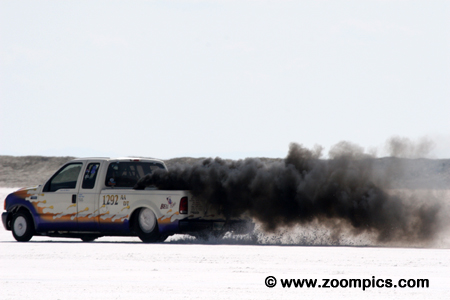
|
No doubt about it, this truck is competing in the Diesel Truck category.
The AA/DT class 1999 Ford F-250 Pickup is powered by a 12V92 Detroit Diesel.
The owner and driver, A.F. Dick, Jr. set a class record in September last year by running a speed of 221.325-mph.
|

|
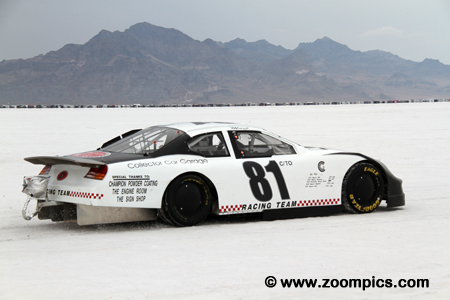
|
This NASCAR based vehicle entered by the Collector Car Garage was not categorized.
The 2004 Dodge Intrepid was driven by the owner, Mark Masterson of El Dorado Hills, California.
The Dodge is powered by a 358-cu.in. Chrysler V8 engine.
|

|
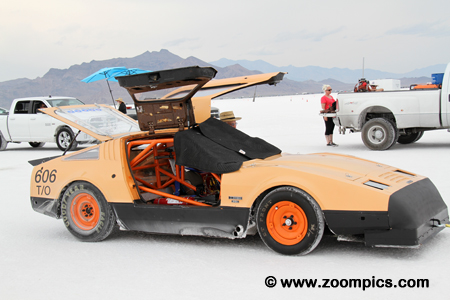
|
The ill-fated Bricklin SV-1 sports car was manufactured in Canada from 1974 to 1975.
The early vehicles were equipped with an American Motors 360-cu.in. engine and later models used Ford’s 351-cu.in. Windsor motor.
Production of the car ceased after the company encountered financial difficulties.
Papa’s Passtime Racing entered a 1975 Ford powered Bricklin driven by Merv Cutright and the owner, Jerry Brown.
|

|
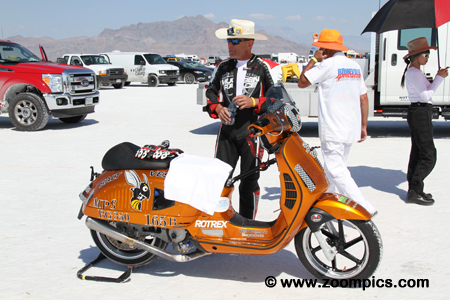
|
This 2010 Vespa GTS proves that there is a class for every vehicle.
The Piaggio Company has been manufacturing Vespa Scooters in Pontedera, Italy since 1946.
This GTS model uses a 330-cc Vespa engine and competes in the M-BG class for 350-cc Motorcycles.
The owner and driver, Tom Haasum hails from Vanlose, Denmark.
|

|

|
This 1979 Porsche 924 was entered in the Classic Production category by Rick Deerwester.
Deerwester drove the 2.0-liter powered-Porsche to a new record.
During his best run, he was clocked at 145.632-mph besting the old record for the G/CPRO class by 6.826-mph.
|

|
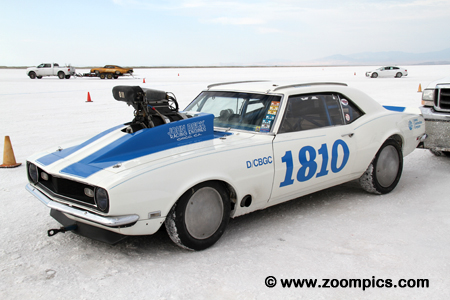
|
Reno, Nevada resident, Tony Taormina entered this 1968 Chevrolet Camaro in the Classic Blown Gas Coupe class (D/CBGC) which
falls under the Classic Category. Taormina owns and drives the Camaro which is powered by a 302-cu.in. Chevrolet engine.
|
|
Copyright Notice:
|
All content (photographs and text) appearing on this website are the exclusive property of © www.zoompics.com and are protected under International copyright laws. The subject matter on this website may not be reproduced, copied, stored or manipulated.
|
© Copyright 1999, 2000, 2001, 2002, 2003, 2004, 2005, 2006, 2007, 2008, 2009, 2010, 2011, 2012, 2013, 2014, 2015, 2016 and 2017


